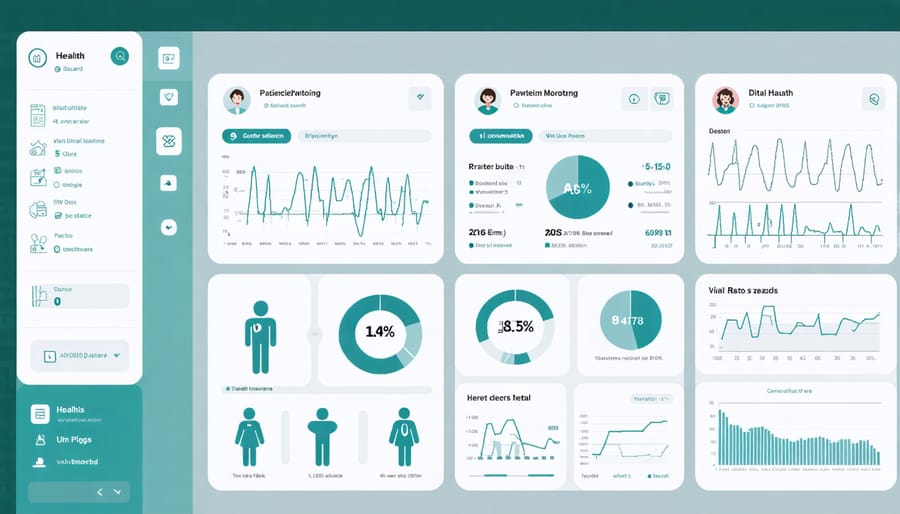Transform healthcare delivery by leading decisive digital initiatives that align with patient-centric care models and emerging technologies. In today’s rapidly evolving digital transformation landscape, healthcare organizations must balance innovation with practical implementation strategies.
Canadian healthcare leaders are uniquely positioned to leverage digital solutions that enhance patient outcomes while maintaining our universal healthcare principles. From AI-powered diagnostics to integrated electronic health records, the opportunities for meaningful transformation are substantial and immediate.
Success demands a strategic approach that addresses three critical elements: organizational readiness, technological infrastructure, and change management. By focusing on these core components, healthcare administrators can drive sustainable digital adoption while maintaining operational excellence and regulatory compliance.
The path forward requires bold leadership, measured implementation, and unwavering commitment to improving patient care through digital innovation. Healthcare organizations that embrace this transformation now will set new standards for care delivery and operational efficiency in the Canadian healthcare system.
The Digital Healthcare Landscape in Canada
Current Digital Health Technologies
Canadian healthcare institutions are rapidly adopting innovative digital solutions to enhance patient care and operational efficiency. Electronic Health Records (EHRs) have become the foundation of modern healthcare delivery, with provinces like Alberta and Ontario leading implementation efforts. Telehealth platforms have experienced unprecedented growth, enabling remote consultations and monitoring while improving access to care in rural communities.
Advanced analytics and artificial intelligence applications are transforming diagnostic capabilities, with organizations like Toronto’s University Health Network pioneering AI-driven medical imaging analysis. Mobile health applications and patient portals are empowering Canadians to actively participate in their healthcare journey, while robust digital healthcare security measures ensure patient data protection.
The Canada Health Infoway reports that 94% of primary care physicians now use electronic medical records, demonstrating widespread digital adoption. Virtual care solutions have become essential tools, with platforms like Ontario Telemedicine Network facilitating over 1 million virtual consultations annually. These technologies are complemented by emerging solutions in cloud computing, blockchain for health records, and Internet of Medical Things (IoMT) devices, creating an increasingly connected healthcare ecosystem.

Regional Success Stories
Across Canada, healthcare organizations are achieving remarkable success through digital transformation initiatives. In British Columbia, Vancouver Coastal Health’s implementation of a unified electronic health record system has reduced wait times by 35% and improved patient satisfaction scores significantly. The system now serves over 1 million patients annually.
In Ontario, Women’s College Hospital in Toronto pioneered virtual care solutions that have enabled 70% of follow-up consultations to be conducted remotely, dramatically improving access for patients in remote communities. Their digital-first approach has become a model for other institutions across the country.
Quebec’s innovative approach to telehealth through the RUIS McGill network has connected over 100 remote communities with specialized medical services, reducing patient travel costs by millions annually. Meanwhile, Nova Scotia’s province-wide digital imaging system has cut diagnostic waiting times in half while enabling seamless collaboration between healthcare providers.
Alberta Health Services’ Connect Care initiative stands out for its comprehensive approach to digital integration, successfully connecting more than 400 healthcare facilities and enabling real-time access to patient information for authorized healthcare providers.
Strategic Leadership in Healthcare Transformation

Building Digital Culture
Building a strong digital culture is fundamental to successful healthcare transformation. Leaders must foster an environment where innovation thrives and staff feel empowered to embrace technological change. As healthcare organizations across Canada progress in their digital workforce adaptation, creating the right cultural foundation becomes increasingly critical.
Dr. Sarah Chen, Chief Digital Officer at Vancouver General Hospital, emphasizes that “cultural transformation must precede digital transformation.” This involves establishing clear channels for feedback, celebrating digital wins, and ensuring all team members understand how technology enhances patient care rather than replacing human touch.
Successful organizations typically implement these key cultural initiatives:
– Regular digital literacy training programs
– Cross-functional innovation teams
– Dedicated time for exploring new technologies
– Recognition programs for digital champions
– Open communication channels for sharing concerns and ideas
The Women’s College Hospital in Toronto demonstrates the power of cultural transformation through their Digital Health Innovation Strategy. By creating innovation labs where frontline staff collaborate with tech specialists, they’ve achieved 85% staff engagement in digital initiatives.
To build digital resilience, healthcare leaders should:
– Encourage experimentation and learning from failure
– Create mentorship programs pairing tech-savvy staff with those less confident
– Establish clear governance frameworks for digital initiatives
– Provide ongoing support and resources for skill development
– Measure and communicate digital transformation progress regularly
Remember that cultural change takes time and consistent effort. Start with small wins, build momentum, and maintain open dialogue throughout the journey.
Change Management Strategies
Successful digital transformation in healthcare requires a well-structured change management approach that addresses both technological and human elements. Healthcare organizations must first create a clear vision of the desired future state and communicate it effectively across all levels of staff.
A phased implementation strategy has proven particularly effective in Canadian healthcare settings. For instance, Toronto’s University Health Network successfully implemented their digital transformation by breaking down the process into manageable stages, allowing staff to adapt gradually while maintaining quality patient care.
Key elements of effective change management include:
Creating dedicated change champions within each department who can support and guide their colleagues through the transition. These individuals should receive specialized training and have direct access to the transformation leadership team.
Establishing comprehensive training programs that cater to different learning styles and technical comfort levels. Regular feedback sessions help identify and address concerns early in the process.
Developing clear communication channels that keep all stakeholders informed about progress, challenges, and wins. This transparency helps build trust and maintain momentum throughout the transformation journey.
Measuring and celebrating small victories along the way helps maintain staff engagement and demonstrates the tangible benefits of digital adoption. The Ottawa Hospital’s successful implementation of electronic health records showcases how celebrating incremental achievements can boost staff morale and adoption rates.
Organizations should also create support systems to help staff navigate technical challenges and adapt to new workflows. This includes providing 24/7 technical support during critical implementation phases and maintaining open dialogue between frontline staff and leadership.
Remember that resistance to change is natural, but can be effectively managed through empathy, clear communication, and demonstrable benefits to both staff and patient care.

Implementation Framework
Assessment and Planning
A successful digital transformation begins with a comprehensive assessment of your current healthcare systems and technological infrastructure. Start by conducting a thorough audit of existing digital capabilities, identifying gaps, and evaluating staff digital literacy levels. This baseline understanding will inform your strategic planning process.
Create a detailed transformation roadmap that aligns with your organization’s goals and available resources. As demonstrated by Toronto’s University Health Network, effective planning involves stakeholder consultation and clear prioritization of initiatives. Consider both immediate needs and long-term objectives while maintaining flexibility to adapt to emerging technologies and changing healthcare demands.
Establish measurable key performance indicators (KPIs) to track progress and ROI. These might include patient satisfaction scores, workflow efficiency metrics, and clinical outcome improvements. The Canadian Medical Association recommends focusing on metrics that directly impact patient care quality and operational efficiency.
Risk assessment is crucial during this phase. Identify potential challenges related to data security, system integration, and change management. Develop mitigation strategies and contingency plans to address these risks proactively. Consider partnering with experienced healthcare technology consultants who understand the Canadian healthcare landscape and compliance requirements.
Remember to account for budget constraints and funding opportunities, including government grants and private sector partnerships that can support your digital initiatives. Regular review and adjustment of your transformation plan ensures continued alignment with organizational objectives and emerging healthcare trends.
Technology Integration
Successful technology integration in healthcare requires a systematic approach to selecting and implementing digital solutions. Start by conducting a thorough needs assessment, involving key stakeholders from clinical, administrative, and IT departments. This collaborative approach ensures the chosen solutions address actual operational challenges while maintaining focus on patient care quality.
When evaluating potential solutions, prioritize interoperability with existing systems. Canadian healthcare organizations have found success by selecting platforms that comply with national health data standards and security requirements. For example, Toronto’s University Health Network demonstrated effective integration by implementing a phased approach to their digital health records system.
Consider these essential criteria when selecting technology:
– Scalability to accommodate future growth
– Security features that meet Canadian privacy regulations
– User-friendly interfaces for staff adoption
– Reliable vendor support and training programs
– Cost-effectiveness and ROI potential
Implementation should follow a clear timeline with defined milestones. Create a dedicated implementation team and establish regular check-ins to monitor progress. Many successful Canadian hospitals have adopted a “start small, scale fast” approach, beginning with pilot programs in specific departments before expanding hospital-wide.
Ensure comprehensive staff training programs are in place before launch. Organizations like Alberta Health Services have shown that investing in change management and ongoing support significantly improves adoption rates and overall project success. Regular feedback sessions during implementation help identify and address challenges early, maintaining momentum throughout the digital transformation process.
Staff Training and Support
Developing digital competencies across healthcare teams requires a structured and inclusive approach. Dr. Sarah Chen, Chief Digital Officer at Vancouver General Hospital, emphasizes that “successful digital transformation depends on bringing every team member along on the journey, not just the tech-savvy ones.”
Start by conducting a digital skills assessment to identify gaps and establish baseline competencies. Create personalized learning paths that accommodate different skill levels and roles within your organization. Consider implementing a buddy system where digitally confident staff members mentor those who need additional support.
Invest in comprehensive training programs that combine hands-on workshops, online modules, and real-world application scenarios. Focus on practical skills that directly relate to daily workflows, such as electronic health record management, telehealth platforms, and digital communication tools.
Toronto’s Mount Sinai Hospital demonstrates the effectiveness of this approach through their Digital Champions program, where designated staff members receive advanced training and serve as on-floor resources for their colleagues. This peer-support model has significantly improved digital adoption rates and reduced resistance to new technologies.
Maintain ongoing support through help desk services, regular check-ins, and refresher training sessions. Remember that digital transformation is a continuous journey, not a destination. Celebrate small wins and recognize staff members who embrace and champion digital solutions in their work.
Consider establishing partnerships with local tech companies and educational institutions to provide additional training resources and keep your team updated on emerging healthcare technologies.
Measuring Success
Measuring the success of digital transformation initiatives in healthcare requires a comprehensive framework of key performance indicators (KPIs) aligned with organizational goals. Successful healthcare data analytics implementation begins with establishing clear baseline metrics and monitoring progress through both quantitative and qualitative measures.
Primary KPIs should focus on patient outcomes, operational efficiency, and financial performance. Key metrics include patient satisfaction scores, wait time reduction, clinical workflow efficiency, and return on digital investments. Canadian healthcare organizations are increasingly tracking digital adoption rates among staff and patients, particularly for telemedicine platforms and electronic health records.
Dr. Sarah Thompson, Chief Digital Officer at Vancouver General Hospital, emphasizes the importance of measuring staff engagement: “We’ve found that tracking user adoption rates and gathering regular feedback from healthcare providers helps us identify areas for improvement and ensures sustainable transformation.”
Financial metrics should encompass both cost savings and revenue generation through digital initiatives. These might include reduced administrative costs, improved resource allocation, and increased patient throughput. Healthcare organizations should also monitor cybersecurity metrics and compliance indicators to ensure digital solutions meet privacy standards.
Consider implementing a balanced scorecard approach that includes:
– Patient experience metrics
– Clinical quality indicators
– Digital solution adoption rates
– Cost efficiency measures
– Staff satisfaction scores
– Security and compliance metrics
Regular assessment intervals, typically quarterly, allow organizations to adjust strategies based on performance data while maintaining momentum in their digital transformation journey.
Canada stands at the forefront of healthcare innovation, with digital transformation reshaping how we deliver and receive medical care. The successful implementation of digital health solutions across provinces has demonstrated that technological advancement and quality patient care go hand in hand. From virtual care platforms in British Columbia to Ontario’s integrated health records systems, these achievements provide a roadmap for future developments.
Looking ahead, the integration of artificial intelligence, remote monitoring solutions, and personalized medicine will continue to evolve, creating more efficient and accessible healthcare services. Healthcare leaders must remain adaptable and forward-thinking, embracing change while maintaining focus on patient outcomes and privacy protection.
To succeed in this digital evolution, organizations should prioritize staff training, secure sustainable funding, and foster partnerships with technology providers. The pandemic has accelerated digital adoption, creating momentum that healthcare leaders can build upon. By maintaining this collaborative approach and commitment to innovation, Canada’s healthcare system will continue to transform, delivering enhanced care experiences for all Canadians.
The future of healthcare is digital, and Canadian organizations that embrace this transformation today will be better positioned to meet tomorrow’s challenges and opportunities.
